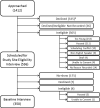Emergency Department Use in a Cohort of Older Homeless Adults: Results From the HOPE HOME Study
- PMID: 27520382
- PMCID: PMC5857347
- DOI: 10.1111/acem.13070
Emergency Department Use in a Cohort of Older Homeless Adults: Results From the HOPE HOME Study
Abstract
Objective: The median age of single homeless adults is over 50, yet little is known about their emergency department (ED) use. We describe use of and factors associated with ED use in a sample of homeless adults 50 and older.
Methods: We recruited 350 participants who were homeless and 50 or older in Oakland, California. We interviewed participants about residential history in the prior 6 months, health status, health-related behaviors, and health services use and assessed cognition and mobility. Our primary outcome was the number of ED visits in the prior 6 months based on medical record review. We used negative binomial regression to examine factors associated with ED use.
Results: In the 6 months prior to enrollment, 46.3% of participants spent the majority of their time unsheltered; 25.1% cycled through multiple institutions including shelters, hospitals, and jails; 16.3% primarily stayed with family or friends; and 12.3% had become homeless recently after spending much of the prior 6 months housed. Half (49.7%) of participants made at least one ED visit in the past 6 months; 6.6% of participants accounted for 49.9% of all visits. Most (71.8%) identified a regular non-ED source of healthcare; 7.3% of visits resulted in hospitalization. In multivariate models, study participants who used multiple institutions (incidence rate ratio [IRR] = 2.27; 95% confidence interval [CI] = 1.08 to 4.77) and who were unsheltered (IRR = 2.29; 95% CI = 1.17 to 4.48) had higher ED use rates than participants who had been housed for most of the prior 6 months. In addition, having health insurance/coverage (IRR = 2.6; CI = 1.5 to 4.4), a history of psychiatric hospitalization (IRR = 1.80; 95% CI = 1.09 to 2.99), and severe pain (IRR = 1.72; 95% CI = 1.07 to 2.76) were associated with higher ED visit rates.
Conclusions: A sample of adults aged 50 and older who were homeless at study entry had higher rates of ED use in the prior 6 months than the general U.S. age-matched population. Within the sample, ED use rates varied based on individuals' residential histories, suggesting that individuals' ED use is related to exposure to homelessness.
© 2016 by the Society for Academic Emergency Medicine.
Conflict of interest statement
Figures


Similar articles
-
Residential patterns in older homeless adults: Results of a cluster analysis.Soc Sci Med. 2016 Mar;153:131-40. doi: 10.1016/j.socscimed.2016.02.004. Epub 2016 Feb 10. Soc Sci Med. 2016. PMID: 26896877 Free PMC article.
-
Concurrent Disorders and Health Care Utilization Among Homeless and Vulnerably Housed Persons in Canada.J Dual Diagn. 2018 Jan-Mar;14(1):21-31. doi: 10.1080/15504263.2017.1392055. Epub 2018 Apr 25. J Dual Diagn. 2018. PMID: 29494795
-
Emergency department use and hospitalizations among homeless adults with substance dependence and mental disorders.Addict Sci Clin Pract. 2015 Aug 5;10:17. doi: 10.1186/s13722-015-0038-1. Addict Sci Clin Pract. 2015. PMID: 26242968 Free PMC article.
-
Homelessness and Emergency Medicine: A Review of the Literature.Acad Emerg Med. 2018 May;25(5):577-593. doi: 10.1111/acem.13358. Epub 2018 Jan 11. Acad Emerg Med. 2018. PMID: 29223132 Review.
-
The role of the emergency department in the care of homeless and disadvantaged populations.Emerg Med Clin North Am. 2006 Nov;24(4):839-48. doi: 10.1016/j.emc.2006.06.011. Emerg Med Clin North Am. 2006. PMID: 16982342 Review.
Cited by
-
The Rapid Evaluation of COVID-19 Vaccination in Emergency Departments for Underserved Patients Study.Ann Emerg Med. 2021 Oct;78(4):502-510. doi: 10.1016/j.annemergmed.2021.05.026. Epub 2021 May 31. Ann Emerg Med. 2021. PMID: 34272104 Free PMC article.
-
Joining Health Care and Homeless Data Systems Using Privacy-Preserving Record-Linkage Software.Am J Public Health. 2021 Aug;111(8):1400-1403. doi: 10.2105/AJPH.2021.306304. Am J Public Health. 2021. PMID: 34464174 Free PMC article. No abstract available.
-
Markedly poor physical functioning status of people experiencing homelessness admitted to an acute hospital setting.Sci Rep. 2021 May 10;11(1):9911. doi: 10.1038/s41598-021-88590-0. Sci Rep. 2021. PMID: 33972563 Free PMC article.
-
Strategies to Reduce Frequent Emergency Department Use among Persons Experiencing Homelessness with Mental Health Conditions: a Scoping Review.J Urban Health. 2024 Oct;101(5):968-978. doi: 10.1007/s11524-024-00917-0. Epub 2024 Sep 13. J Urban Health. 2024. PMID: 39269664
-
Prevalence and Temporal Characteristics of Housing Needs in an Urban Emergency Department.West J Emerg Med. 2020 Dec 7;22(2):204-212. doi: 10.5811/westjem.2020.9.47840. West J Emerg Med. 2020. PMID: 33856301 Free PMC article.
References
-
- Hwang SW, Henderson MJ. Health Care Utilization in Homeless People: Translating Research into Policy and Practice: Agency for Healthcare Research and Quality. 2010
-
- Mandelberg JH, Kuhn RE, Kohn MA. Epidemiologic analysis of an urban, public emergency department's frequent users. Academic emergency medicine : official journal of the Society for Academic Emergency Medicine. 2000;7:637–46. - PubMed
-
- Tsai J, Rosenheck RA. Risk factors for ED use among homeless veterans. The American journal of emergency medicine. 2013;31:855–8. - PubMed
MeSH terms
Grants and funding
LinkOut - more resources
Full Text Sources
Other Literature Sources
Medical
Miscellaneous

